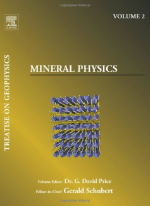Добрый день, Коллеги. Важное сообщение, просьба принять участие. Музей Ферсмана ищет помощь для реставрационных работ в помещении. Подробности по ссылке
Treatise on geophisics. Mineral Physics. Volume 2 / Трактат о геофизике. Физика минералов. Том 2.
Mineral physics involves the application of physics and chemistry techniques in order to understand and predict the fundamental behavior of Earth materials (e.g., Kieffer and Navrotsky, 1985), and hence provide solutions to large-scale problems in Earth and planetary sciences. Mineral physics, therefore, is relevant to all aspects of solid Earth sciences, from surface processes and environmental geochemistry to the deep Earth and the nature of the core. In this volume, however, we focus only on the geophysical applications of mineral physics (see also Ahrens (1995), Hemley (1998), and Poirier (2000)). These applications, however, are not just be constrained to understanding structure the Earth (see Volume 1) and its evolution (see Volume 9), but also will play a vital role in our understanding of the dynamics and evolution of other planets in our solar system (see Volume 10 and Oganov et al. (2005)). As a discipline, mineral physics as such has only been recognized for some 30 years or so, but in fact it can trace its origins back to the very foundations of solid Earth geophysics itself. Thus, for example, the work of Oldham (1906) and Gutenberg (1913), that defined the seismological characteristics of the core, led to the inference on the basis of materials physics that the outer core is liquid because of its inability to support the promulgation of shear waves. A landmark paper in the history of the application of mineral physics to the understanding of the solid Earth is the Density of the Earth by Williamson and Adams (1923). Here the elastic constants of various rock types were used to interpret the density profile as a function of depth within the Earth that had been inferred from seismic and gravitational data. Their work was marked by taking into account the gravitationally induced compression of material at depth within the Earth, which is described by the Williamson–Adams relation that explicitly links geophysical observables (g(r), the acceleration due to gravity as a function of radius, r, and the longitudinal and shear seismic wave velocities Vp and Vs).




